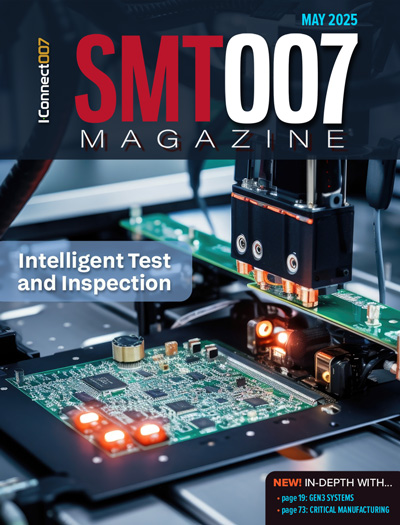-

- News
- Books
Featured Books
- smt007 Magazine
Latest Issues
Current Issue
What's Your Sweet Spot?
Are you in a niche that’s growing or shrinking? Is it time to reassess and refocus? We spotlight companies thriving by redefining or reinforcing their niche. What are their insights?

Moving Forward With Confidence
In this issue, we focus on sales and quoting, workforce training, new IPC leadership in the U.S. and Canada, the effects of tariffs, CFX standards, and much more—all designed to provide perspective as you move through the cloud bank of today's shifting economic market.

Intelligent Test and Inspection
Are you ready to explore the cutting-edge advancements shaping the electronics manufacturing industry? The May 2025 issue of SMT007 Magazine is packed with insights, innovations, and expert perspectives that you won’t want to miss.
- Articles
- Columns
- Links
- Media kit
||| MENU - smt007 Magazine
Cortus Launches Low-Power Floating Point Processor for Intelligent Connected Devices
December 11, 2015 | CortusEstimated reading time: 2 minutes
Cortus, a technology leader in low power, silicon efficient, 32-bit processor IP, announced the release of the FPS26 single precision floating point IP core today, the third in a family of products based on the Cortus v2 instruction set. The core is aimed at embedded systems requiring good floating point computational performance while also delivering small silicon area and low power dissipation.
Cortus licenses a range of low power 32-bit processor cores for intelligent connected devices. With growing numbers of controllers in solar energy and industrial control requiring floating point algorithms, many applications require floating point operations executed in hardware to achieve their performance goals. Complex matrix inversion is a challenging computation in MIMO (multiple-input and multiple-output) wireless systems due to challenges around precision, quantisation and scaling which can be mitigated by using floating point.
“For companies developing intelligent ‘things’ requiring floating point algorithms, our FPS26 core offers outstanding computational performance while efficiently using silicon area”, says Michael Chapman President & CEO of Cortus. “It is an excellent fit with the industrial internet of things and with power control applications”.
Although historically embedded software has been dominated by fixed-point operations, there are cases where values may have large dynamic ranges and floating point computation is required or advantageous. Examples include matrix inversion in MIMO baseband processing, matrix multiplication and fast Fourier transforms (FFTs).
The FPS26 has a Harvard architecture, sixteen 32-bit registers and a 5-stage pipeline. It offers an IEEE 754 single precision hardware floating point unit, a pipelined parallel multiplier and a hardware divider. It supports the AXI4-Lite™ bus as well as Cortus APS peripherals. The small size of FPS26 makes it highly suitable for cost sensitive applications. The CPU starts at around 0.192 mm2 using a 90 nm technology. Using the Linpack benchmark FPS26 delivers 9.7 times better floating point performance than the APS25 integer core.
Page 1 of 2
Suggested Items
I-Connect007’s Editor’s Choice: Five Must-Reads for the Week
07/04/2025 | Marcy LaRont, I-Connect007For our industry, we have seen several bullish market announcements over the past few weeks, including one this week by IDC on the massive growth in the global server market. We’re also closely watching global trade and nearshoring. One good example of successful nearshoring is Rehm Thermal Systems, which celebrates its 10th anniversary in Mexico and the official opening of its new building in Guadalajara.
Driving Innovation: Direct Imaging vs. Conventional Exposure
07/01/2025 | Simon Khesin -- Column: Driving InnovationMy first camera used Kodak film. I even experimented with developing photos in the bathroom, though I usually dropped the film off at a Kodak center and received the prints two weeks later, only to discover that some images were out of focus or poorly framed. Today, every smartphone contains a high-quality camera capable of producing stunning images instantly.
United Electronics Corporation Advances Manufacturing Capabilities with Schmoll MDI-ST Imaging Equipment
06/24/2025 | United Electronics CorporationUnited Electronics Corporation has successfully installed the advanced Schmoll MDI-ST (XL) imaging equipment at their advanced printed circuit board facility. This significant technology investment represents a continued commitment to delivering superior products and maintaining their position as an industry leader in precision PCB manufacturing.
Orbel Corporation Integrates Schmoll Direct Imaging
06/04/2025 | Schmoll AmericaOrbel Corporation in Easton, PA, proudly becomes the first PCM facility in the U.S. equipped with Schmoll’s MDI Direct Imaging system. This installation empowers Orbel to support customers with greater precision and quality.
Key Insights on Photoresist for Defect Reduction
05/21/2025 | I-Connect007 Editorial TeamIn PCB manufacturing, understanding the intricacies of the photoresist process is crucial for achieving high-quality results. Industry experts Josh Krick, a technical service engineer at IEC, and Tim Blair, a PCB imaging specialist at Tim Blair LLC, share their knowledge on the essential stages of photoresist application, highlight critical advancements in materials, and discuss common defects encountered during production. They share best practices and innovative solutions to enhance the manufacturing process, reduce defects, and ensure efficiency and reliability in high-tech applications.


